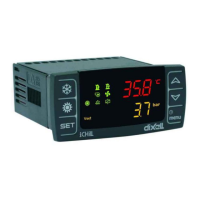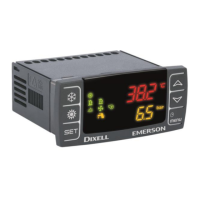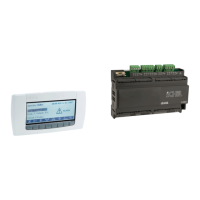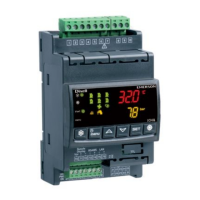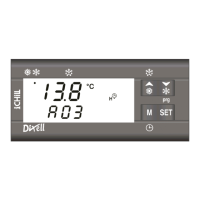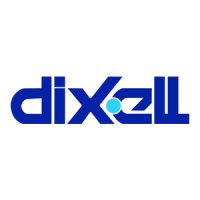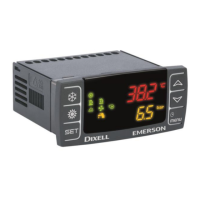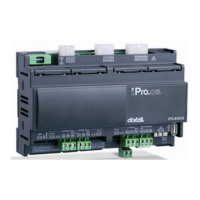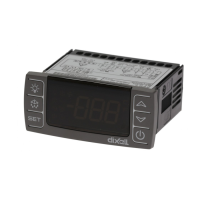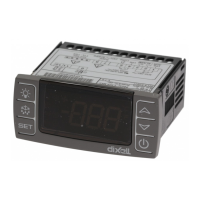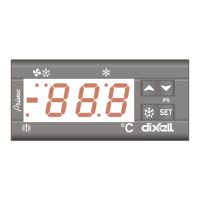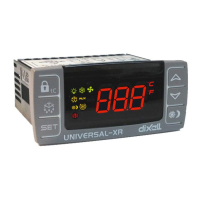Do you have a question about the dixell iPRO and is the answer not in the manual?
Avoid exposing the appliance to rain or moisture and do not remove covers to reduce shock risk.
Alerts users to dangerous voltage presence and important operating/maintenance instructions.
Manual is part of the product, use only as described, not as a safety device.
Check supply voltage, separate wires, use mains filters if needed.
Highlights advanced connectivity, processing speed, ISaGRAF development, and VISOGRAPH HMI.
Details operating system, CPU, memory, I/O, connectivity options, power, and environmental specs.
Covers alarm sending via email/SMS, internet, modem connections, and remote commands.
Introduces ISaGRAF as a development environment for creating control systems.
Describes IPRO-TOOL and VISOPROG software for programming and interface creation.
Lists minimum hardware and software requirements for PC connection and programming.
Specifies the power supply requirements for the iPRO controller.
Details configurations for PTC-NTC probes, 4-20mA, and 0-10V analog inputs.
Explains configurations for 0-10V, 4-20mA, and PWM analog outputs.
Covers the configuration and wiring for digital inputs and outputs.
Details Visograph connection and expansion module specifications.
Explains connecting the iPRO via Ethernet for programming and communication.
Guides on establishing a direct connection between PC and iPRO using a crossover cable.
Details connecting the iPRO within a Local Area Network.
Covers port forwarding for remote access and modem connection setup.
Lists necessary software and hardware (ISaGRAF USB KEY) for development.
Step-by-step instructions for installing the ISaGRAF software on a PC.
Guide on obtaining the ISaGRAF software from the official website.
Instructions for copying template projects and general function libraries.
Steps to open and begin a new project in the ISaGRAF environment.
Defines core concepts like Resource, Programs, and PLC Cycle timing.
Example of developing an ON-OFF regulator using the ST language.
Explains how to enable and use the step-by-step debugging feature.
Provides the file path to the complete ISaGRAF development tool documentation.
Covers statements, operators, time, string manipulation, and conversion functions.
Introduces the Function Block Diagram (FBD) language for programming.
Demonstrates creating an ON/OFF regulator using the FBD language.
Explains the concept, benefits, and characteristics of Function Blocks (FBs).
Details how to create custom Function Blocks for control logic.
Guides on incorporating and utilizing created Function Blocks in applications.
Describes the process of transferring Function Blocks between projects.
Explains .conf, .bin, .param, and .spalt file types and their usage.
Details how to set and manage passwords for application security.
Explains methods for moving applications between iPRO, PC, and USB.
Guides on password-protecting individual Function Blocks.
Defines the required folder structure on a USB key for iPRO file management.
Step-by-step guide for transferring files to and from the iPRO using a USB key.
Instructions for installing the VISOPROG application, including product key entry.
Details the process for activating the VISOPROG software license.
Covers configuring language, connection, and project options.
Explains how to select and customize the user interface language.
Defines how to establish the connection between the PC and the iPRO device.
Details settings for developer info, baud rate, project description, fonts, and vocabulary.
Introduces the VISOPROG workbench for building VISOGRAPH interfaces.
Describes the STAGE, STAGE EDITOR, and INFORMATION areas of the workbench.
Explains how to add, edit, import, and delete stages within a project.
Details using controls like VarLabel, DXLabel, DxImage for interface design.
Covers Object Properties, Main View, Variables, Vocabulary, and View State.
Provides guidance on starting and setting up new VISOPROG projects.
Adjusting decimal points, ScrollLock options, and SET/BAND value modification.
Explains creating button combinations for multi-stage navigation and variable control.
Setting up conditions for control visibility, including blinking effects.
Automating the creation of stages with predefined controls and layouts.
Summarizes properties of RS485, Ethernet, and CAN bus connections.
Guides on preparing for bus configuration and variable management.
Steps for adding and configuring the GENLINE board for bus communication.
Instructions for adding and configuring GENAI, GENAO, GENDI, GENDO I/O boards.
Process for declaring new variables with their Name, Type, Direction, and Attribute.
Explains how to establish connections between variables and I/O boards.
Details on accessing the iPRO's web interface for configuration and status monitoring.
Instructions for checking and modifying network settings and system status.
How to check application variables and change their values via the web interface.
Avoid exposing the appliance to rain or moisture and do not remove covers to reduce shock risk.
Alerts users to dangerous voltage presence and important operating/maintenance instructions.
Manual is part of the product, use only as described, not as a safety device.
Check supply voltage, separate wires, use mains filters if needed.
Highlights advanced connectivity, processing speed, ISaGRAF development, and VISOGRAPH HMI.
Details operating system, CPU, memory, I/O, connectivity options, power, and environmental specs.
Covers alarm sending via email/SMS, internet, modem connections, and remote commands.
Introduces ISaGRAF as a development environment for creating control systems.
Describes IPRO-TOOL and VISOPROG software for programming and interface creation.
Lists minimum hardware and software requirements for PC connection and programming.
Specifies the power supply requirements for the iPRO controller.
Details configurations for PTC-NTC probes, 4-20mA, and 0-10V analog inputs.
Explains configurations for 0-10V, 4-20mA, and PWM analog outputs.
Covers the configuration and wiring for digital inputs and outputs.
Details Visograph connection and expansion module specifications.
Explains connecting the iPRO via Ethernet for programming and communication.
Guides on establishing a direct connection between PC and iPRO using a crossover cable.
Details connecting the iPRO within a Local Area Network.
Covers port forwarding for remote access and modem connection setup.
Lists necessary software and hardware (ISaGRAF USB KEY) for development.
Step-by-step instructions for installing the ISaGRAF software on a PC.
Guide on obtaining the ISaGRAF software from the official website.
Instructions for copying template projects and general function libraries.
Steps to open and begin a new project in the ISaGRAF environment.
Defines core concepts like Resource, Programs, and PLC Cycle timing.
Example of developing an ON-OFF regulator using the ST language.
Explains how to enable and use the step-by-step debugging feature.
Provides the file path to the complete ISaGRAF development tool documentation.
Covers statements, operators, time, string manipulation, and conversion functions.
Introduces the Function Block Diagram (FBD) language for programming.
Demonstrates creating an ON/OFF regulator using the FBD language.
Explains the concept, benefits, and characteristics of Function Blocks (FBs).
Details how to create custom Function Blocks for control logic.
Guides on incorporating and utilizing created Function Blocks in applications.
Describes the process of transferring Function Blocks between projects.
Explains .conf, .bin, .param, and .spalt file types and their usage.
Details how to set and manage passwords for application security.
Explains methods for moving applications between iPRO, PC, and USB.
Guides on password-protecting individual Function Blocks.
Defines the required folder structure on a USB key for iPRO file management.
Step-by-step guide for transferring files to and from the iPRO using a USB key.
Instructions for installing the VISOPROG application, including product key entry.
Details the process for activating the VISOPROG software license.
Covers configuring language, connection, and project options.
Explains how to select and customize the user interface language.
Defines how to establish the connection between the PC and the iPRO device.
Details settings for developer info, baud rate, project description, fonts, and vocabulary.
Introduces the VISOPROG workbench for building VISOGRAPH interfaces.
Describes the STAGE, STAGE EDITOR, and INFORMATION areas of the workbench.
Explains how to add, edit, import, and delete stages within a project.
Details using controls like VarLabel, DXLabel, DxImage for interface design.
Covers Object Properties, Main View, Variables, Vocabulary, and View State.
Provides guidance on starting and setting up new VISOPROG projects.
Adjusting decimal points, ScrollLock options, and SET/BAND value modification.
Explains creating button combinations for multi-stage navigation and variable control.
Setting up conditions for control visibility, including blinking effects.
Automating the creation of stages with predefined controls and layouts.
Summarizes properties of RS485, Ethernet, and CAN bus connections.
Guides on preparing for bus configuration and variable management.
Steps for adding and configuring the GENLINE board for bus communication.
Instructions for adding and configuring GENAI, GENAO, GENDI, GENDO I/O boards.
Process for declaring new variables with their Name, Type, Direction, and Attribute.
Explains how to establish connections between variables and I/O boards.
Details on accessing the iPRO's web interface for configuration and status monitoring.
Instructions for checking and modifying network settings and system status.
How to check application variables and change their values via the web interface.
| Series | iPRO |
|---|---|
| Accuracy | ±0.5% f.s. +1 digit |
| Resolution | 0.1°C |
| Digital inputs | 4 |
| Analog inputs | 4 |
| Inputs | digital |
| Relay outputs | 4 |
| Outputs | Relay |
| Serial communication | RS485 (Modbus RTU) |
| Display | LCD with backlight |
| Measuring range | -50°C to +150°C (depending on sensor) |
| Humidity | 10…90% RH, without condensation |
